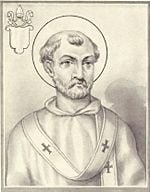Pope Anterus
| Saint Anterus | |
|---|---|

| |
| Birth name | Anterus |
| Papacy began | November 21, 235 |
| Papacy ended | January 3, 236 |
| Predecessor | Pontian |
| Successor | Fabian |
| Born | ??? ??? |
| Died | January 3 236 Rome, Italy |
Pope Saint Anterus was bishop of Rome from November 21, 235 to January 3, 236, succeeding Pope Pontian, who had been deported from Rome, along with the antipope Hippolytus, to Sardinia. His reign was a very short one, lasting only 40 days. Tradition holds that he collected and stored various acts of the martyrs, but most scholars today treat this report with skepticism.
It is claimed that Anterus was himself martyred under the persecutions of Emperor Maximinus the Thracian. However, while it is true that his predecessor died in exile in the Sandinian mines, there is no evidence for this being the case with Anterus. He was buried in the papal crypt of the cemetery of St. Callixtus in Rome and later made a saint, as were all the early popes. His tomb was discovered in archaeological investigations in the nineteenth century.
Biography
The Liber Pontificalis indicates that Anterus was a Greek and that his father's name was Romulus. He became pope after his predecessor, Pontian, was sentenced to exile in the Sardinian mines under the persecution of Emperor Maximinus I, known as the Thracian. Nothing else is known of his background, and little if anything is known of his episcopacy, which lasted less than a month and a half.
The congregation of the antipope and later saint Hippolytus, who was exiled with Pontian, may have been reconciled with the main body of the Roman church during Anterus' time, but the sources make it equally possible that this reunion occurred either just before the sentence of exile was enforced, or during the time of Anterus' successor, Pope Fabian.
The idea of his martyrdom is supported by the fact that his predecessor died in the mines after being exiled under persecution, but more telling is the report in the Liberian Catalogue of the popes that he "fell asleep," a euphemism for a natural death.
A later tradition holds that Anterus was martyred for having caused the Acts of the martyrs to be collected by notaries and deposited in the archives of the Roman Church. While this tradition cannot be dismissed out of hand, most scholars today treat it skeptically, since its source, the Liber Pontificalis, is of relatively late date and routinely ascribes to each pope accomplishments that are clearly anachronistic.
Legacy
Anterus was the first bishop of Rome to be buried in the Catacomb of Callixtus, in which many of the early popes would later be entombed. The site of Anterus' sepulcher was discovered by the Italian archaeologist Giovanni Battista de Rossi in 1854, who found some broken remnants of his Greek epitaph engraved on the narrow oblong slab that covered his tomb. A letter once attributed to him is now dismissed as a later forgery. His feast is celebrated on January 3.
| Roman Catholic Popes | ||
|---|---|---|
| Preceded by: Pontian |
Bishop of Rome Pope 235â236 |
Succeeded by: Fabian |
ReferencesISBN links support NWE through referral fees
- Chapman, John. Studies on the Early Papacy. Port Washington, NY: Kennikat Press, 1971. ISBN 9780804611398.
- Duffy, Eamon. Saints and Sinners: A History of the Popes. New Haven: Yale University Press, 2002. ISBN 0300091656.
- Fortescue, Adrian, and Scott M. P. Reid. The Early Papacy: To the Synod of Chalcedon in 451. Southampton: Saint Austin Press, 1997. ISBN 9781901157604.
- Kelly, John N. D., and Michael J. Walsh. The Oxford Dictionary of Popes. Oxford: Oxford Univ. Press, 2005. ISBN 9780198614333.
- Loomis, Louise Ropes. The Book of Popes (Liber Pontificalis). Merchantville, NJ: Evolution Publishing. ISBN 1889758868.
- Maxwell-Stuart, P. G. Chronicle of the Popes: The Reign-by-Reign Record of the Papacy from St. Peter to the Present. New York, NY: Thames and Hudson, 1997. ISBN 0500017980.
- Walsh, Michael J. An Illustrated History of the Popes: Saint Peter to John Paul II. Bonanza Books, 1980. ASIN B000O9Y9I6.
This article incorporates text from the Catholic Encyclopedia, a publication now in the public domain.
| |||||||||||||
Credits
New World Encyclopedia writers and editors rewrote and completed the Wikipedia article in accordance with New World Encyclopedia standards. This article abides by terms of the Creative Commons CC-by-sa 3.0 License (CC-by-sa), which may be used and disseminated with proper attribution. Credit is due under the terms of this license that can reference both the New World Encyclopedia contributors and the selfless volunteer contributors of the Wikimedia Foundation. To cite this article click here for a list of acceptable citing formats.The history of earlier contributions by wikipedians is accessible to researchers here:
The history of this article since it was imported to New World Encyclopedia:
Note: Some restrictions may apply to use of individual images which are separately licensed.